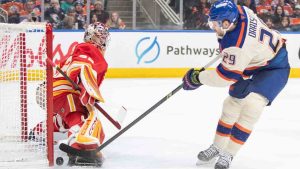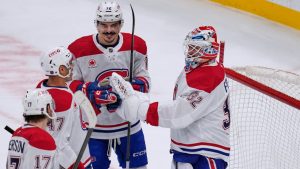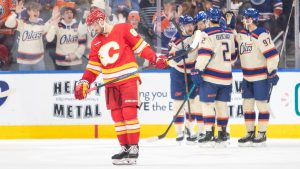As a parent, you can’t help but subscribe — knowingly and unknowingly — to myths.
It turns out that raising kids is neither art nor science, but instead a great leap of faith. You hope for great things, pray against terrible ones and in the end come to recognize either one of those extremes is largely outside your control.
That said, being a fatalist about the job isn’t really an option. So in addition to hugging, cajoling, teaching, encouraging, and nagging, you try to outsource wisely, leaning on examples, role models, dreams, and stories. The idea being, roughly, that something will take root in an innocent heart or mind and offer a beacon, structure or guide that helps get them through.
And then you hope for the best.
In Canada, for decades now, hockey has been an outlet for that kind of thinking. It’s not that every parent who gets their kids up on skates actually believes it will lead to something, it’s that the process — in addition to being fun — will help develop character and build habits that shape a person who can make their way in an increasingly confusing world.
And no organization has benefitted more from the notion of hockey as the fabric that binds than Hockey Canada and its annual participation in the World Juniors.
For those whose holy trinity is Howe, Gretzky, and Orr, it is a holiday tradition with its own set of rituals: puck drop on Boxing Day, the excitement building with a typically crucial rivalry game on New Year’s Eve before the playoffs conclude early in January, just before schools go back in. Canada doesn’t always win but wins enough — 10 times in 26 years — that a World Juniors gold feels like Canada’s to lose. The 18- and 19-year-olds who deliver the goods get all the glory and everyone watching at home gets to reflect themselves in it.
It has always been a decent trade-off.
But the bombshell revelations of alleged group sexual assaults by members of the 2018 World Junior team and – late last week – the 2003 team first reported in each case by Rick Westhead of TSN, threatens to change the equation. Twice in less than 20 years, some of Canada’s best and brightest hockey talent is alleged to have acted out the most disturbing scenes imaginable, implicated in crimes both heinous and seemingly pre-meditated. In each instance, the perpetrators are unnamed but given that multiple members of two rosters are potentially involved it’s impossible for anyone associated with Hockey Canada to argue they were isolated events by rogue actors.
Who knew what? Which secrets were kept out of hockey’s tradition of dressing room omerta?
For the second time this summer Hockey Canada executives will this week have their feet held to the fire by the Standing Committee on Canadian Heritage as politicians from all parties try to discern how many similar incidents Hockey Canada has had to deal with — a valid question since The Globe and Mail reported details of what seems to be a multi-million dollar slush fund Hockey Canada maintained, at least in part, so they could settle potential lawsuits out of court and without involving insurance. As well the committee will ask which processes Hockey Canada normally uses to deal with sexual assault allegations and how transparent they are when they do. The committee also wants to know if public funds have been used to settle claims or if registration fees paid to the organization by everyone from adult beer leaguers to families of minor hockey players have been the source.
To what degree real change can be expected is an open question.
For its part Hockey Canada released a 'comprehensive Action Plan' Monday that it called “an important step in upholding Hockey Canada’s responsibility to address toxic behaviours – both on and off the ice – that conflict with what Canadians expect hockey to be and to confront the culture of silence that exists in corners of the game.”
Under that new plan, it’s not business as usual for players attending Hockey Canada camps this week. Those players had to participate in a Zoom call addressing expectations for conduct before arriving in Calgary and underwent a further session on diversity, equity, and inclusion before they hit the ice Saturday, per sources. The ongoing discussions around the sexual assaults figured prominently in the conversations and an invitation to parents and players to speak to Hockey Canada executives was offered as well.
Will these and other measures be enough to prevent future incidents like those that have been revealed so far?
It’s unknowable. But the idea that hockey’s self-described 'culture of silence' is going anywhere soon borders on laughable. I contacted the families of some players at the current World Junior camp and while their parents were willing to talk, it was only if they remained anonymous due to concerns that any comments made would reflect on their sons at such critical junctures of their careers. It’s understandable and there shouldn’t be an obligation of current and future members of the World Junior teams to speak on the sins of the past. But the anxiety families feel about airing thoughts or concerns publicly is telling. The pervasive urge to say nothing in elite hockey circles is hard-wired.
Similarly, while several players on the 2003 and 2018 teams have released statements in reference to the incidents said to have taken place, they have been uniformly self-exculpatory, representing efforts to distance themselves from the alleged actions of their former teammates and claim that they had no prior knowledge of what went on. Even years after the fact no one adjacent to the alleged events is willing to acknowledge a secret held or a rumour ignored, although these players say they will cooperate with investigations.
In some ways that any of this has happened shouldn’t be a complete shock, even though what allegedly happened is shocking. Only the naïve would believe that all those generations of fresh-faced kids were in real life the flawless young heroes that live only fiction. In any endeavour where there is a race to get through the eye of the needle, character is rarely weighed on the same scale as talent. Compromises are made as anyone who has been around the underbelly of elite anything can attest.
And it’s not as if hockey hasn’t had deeply disturbing scandals before — from sexual abuse by authority figures against vulnerable teenagers away from home to mistreatment of brain injuries to hazing rituals that border on medieval.
But what makes these events somehow different is both their gravity and that the young men who skate across our TV screens every Christmas are — by definition — the best that hockey has to offer, players who were the captains of their teams and the top players on them since they put on skates. They represent the best-case embodiment of all those Tim Horton’s commercials featuring the early morning practices and cozy moments in the car with Mom and Dad.
It's the image that Hockey Canada has mined for years and very lucratively, as commercial sponsors have spent top dollar to have their brands associated with the peak representation of an iconic Canadian archetype.
And yet in at least two instances, not one member of those national junior teams had, in the moment, the moral compass to sort out very wrong from right and speak up against their teammates on behalf of an outsider who needed help. And now — even years after the fact — they are willing only to say 'it wasn’t me' rather than take the brave step and publically support the innocent even if it means implicating a teammate.
It’s a disgrace. It’s reprehensible. For decades Hockey Canada has marketed hockey generally and the World Juniors in particular as a safe place for kids and families to dream big dreams.
Will they be able to again, after this nightmare?
It's hard to imagine, because here’s the thing about myths: once shattered, they don’t get put together again.





